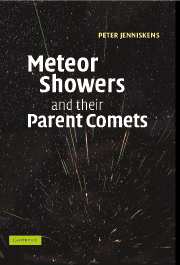Book contents
- Frontmatter
- Dedication
- Contents
- Preface
- Acknowledgements
- Part I Introduction
- Part II Parent bodies
- Part III Young streams from water vapor drag
- 11 Forecasting meteor storms from what planets do to dust trails
- 12 Meteor storm chasing
- 13 Meteor outbursts from long-period comets
- 14 Trapped: the Leonid Filament
- 15 The Leonid storms
- 16 The Ursids
- 17 The Perseids
- 18 Other Halley-type comets
- 19 Dust trails of Jupiter-family comets
- Part IV Young streams from comet fragmentation
- Part V Old streams and sporadic meteoroids
- Part VI Impact and relevance of meteor showers
- Appendix
- Tables
- Index
- Units and constants
11 - Forecasting meteor storms from what planets do to dust trails
from Part III - Young streams from water vapor drag
Published online by Cambridge University Press: 05 July 2015
- Frontmatter
- Dedication
- Contents
- Preface
- Acknowledgements
- Part I Introduction
- Part II Parent bodies
- Part III Young streams from water vapor drag
- 11 Forecasting meteor storms from what planets do to dust trails
- 12 Meteor storm chasing
- 13 Meteor outbursts from long-period comets
- 14 Trapped: the Leonid Filament
- 15 The Leonid storms
- 16 The Ursids
- 17 The Perseids
- 18 Other Halley-type comets
- 19 Dust trails of Jupiter-family comets
- Part IV Young streams from comet fragmentation
- Part V Old streams and sporadic meteoroids
- Part VI Impact and relevance of meteor showers
- Appendix
- Tables
- Index
- Units and constants
Summary
Meteor storm forecasting became feasible in 1867, when it was discovered that comets are responsible for meteor storms. By tracking the changing comet orbit in the gravity field of the Sun and planets, it was possible to predict when and where the comet itself would be near Earth's orbit. It took four more Leonid seasons, before meteor storm forecasting became a reality with the capability of tracking the path of the meteoroids instead.
11.1 The 1872 and 1885 Andromedids
The first successful meteor storm prediction based on the behavior of the parent comet was that for the Andromedid storm of 1872. Following Schiaparelli's work, both Edmond Weiss in Vienna and Heinrich Ludwig d'Arrest at Leipzig Observatory announced in 1867 that Biela's comet was in the same orbit as the Andromedids observed by Brandes on the evening of December 6, 1798. D'Arrest noticed that there had been six complete revolutions by 3D/Biela from the initial report of Brandes to the shower of December 6, 1838, when rates in Europe and the USA were four times as high as in a normal night. These showers occurred in sync with the short 6.6 yr orbit of the comet. However, his prediction of another shower on December 6, 1878, did not pan out.
Weiss found the reason why. By comparing past orbits, he discovered that Jupiter had rotated the comet orbit so that now Earth passed its node a week earlier. Extrapolating, he predicted that a shower in 1872 should occur on about November 28, and not on December 6 when Brandes saw the meteors a century earlier. Weiss' result was quoted, but not believed. Herschel wrote: Should a clear night permit a watch to be kept for these meteors during the last week in November, and the first week in December next, and especially on the nights of the 4th and of the 7th of December, both in this and in next year (1872 and 1873 – PJ), a favourable opportunity exists for verifying practically these ingenious suggestions of Dr. Weiss. Close to the prediction by Weiss, a spectacular storm of slow meteors was observed on November 27, 1872.
Information
- Type
- Chapter
- Information
- Meteor Showers and their Parent Comets , pp. 153 - 160Publisher: Cambridge University PressPrint publication year: 2006
